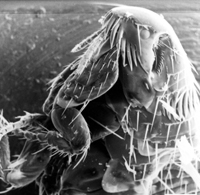
The common flea can carry Rickettsia felis bacteria in its cells How do you study a pathogen that can't survive outside its host's cells? In a new study published in the open access journal PLoS Biology, Hiroyuki Ogata and colleagues show that sequencing and analyzing the genome of the bacteria Rickettsia felis provide valuable insights into the biology and behavior of this intracellular pathogen. The researchers discovered that the parasitic bacterium has the standard large circular chromosome plus two unexpected plasmids, small circular pieces of DNA that can replicate on their own. This discovery may lead to novel techniques for study. "The newly identified plasmids may become a basis of a new tool, such as for efficiently producing rickettsial proteins," explains Ogata.
Other Rickettsia species include the pathogens responsible for typhus and Rocky Mountain spotted fever. "Up to now, due to the lack of appropriate genetic transformation tools for rickettsiae, detailed molecular studies were difficult for these bacteria," says Ogata. But with new tools and "because of the medical importance of this group of bacteria, different teams of researchers are sequencing the genomes of different species of Rickettsia felis. We determined the genome sequence of Rickettsia felis, which is the fourth Rickettsia genome completely determined." R. felis is the only species known to have a plasmid.
Ogata and colleagues also made surprising discoveries about sexual activity in these bacteria. The larger plasmid encoded proteins typically associated with bacterial sex, called conjugation. The researchers also observed pilli, the bacterial conjugation bridge. Previously, researchers believed that intracellular bacteria did not exchange genetic material with each other. But Ogata explains that the new findings "forced us to change this static view."
In addition to conjugation, the researchers found evidence of other mechanisms for the bacterium to reshuffle its DNA. The R. felis genome encodes a large number of transposases, enzymes that cut and paste chromosomal DNA, and bears traces of multiple types of mobile gene elements and acquisition of genes from other, non-rickettsial, bacteria.
The research demonstrates that genomic analysis can provide new information about an organism efficiently. "Our study demonstrates the importance of sequencing a bacterial genome, even if several closely related genomes have been already determined. It is very difficult to correctly forejudge the diversity of bacterial genomes," Ogata says. "Thus we have to sequence more."
###
Citation: Ogata H, Renesto P, Audic S, Robert C, Blanc G, et al. (2005) The genome sequence of Rickettsia felis identifies the first putative conjugative plasmid in an obligate intracellular parasite. PLoS Biol 3(8): e248.
 Print Article
Print Article Mail to a Friend
Mail to a Friend
